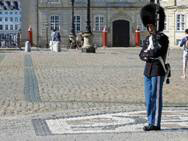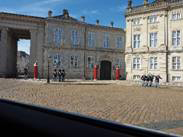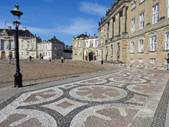This is Carol's second and my third time in Copenhagen. The last time was when we were on a business trip to Moscow and stopped over for a quick visit. The first time for me was 50 years ago so there will be another comparative visit at the end of this piece.
Today we asked to be treated as a first time visitors and to be taken to as many places of interest as possible. The guide was a retired air traffic controller. The driver works for a company that transports visiting royalty and diplomats when they come to Copenhagen. This all worked out well for us and meant that we would be able to talk about and share pictures of a lot more sights including off-the-beaten-tracks ones.
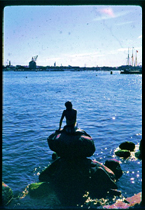
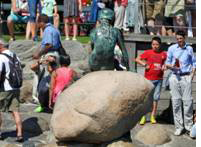 Our first stop was to visit the icon of Copenhagen, the Little Mermaid. I didn't remember it being so close to shore and so easy to see once you could get close to it on the walkway. The picture on the left is today, the one on the right was 50 years go. One major difference is the Chinese tourists. Apparently after Denmark allowed the Little Mermaid to go to China on a good will tour, the Chinese people were encouraged to go see it in place in Copenhagen. It appeared that the populace interpreted this order to mean that they all come at once - along with their selfie-sticks and ipads.
Our first stop was to visit the icon of Copenhagen, the Little Mermaid. I didn't remember it being so close to shore and so easy to see once you could get close to it on the walkway. The picture on the left is today, the one on the right was 50 years go. One major difference is the Chinese tourists. Apparently after Denmark allowed the Little Mermaid to go to China on a good will tour, the Chinese people were encouraged to go see it in place in Copenhagen. It appeared that the populace interpreted this order to mean that they all come at once - along with their selfie-sticks and ipads.
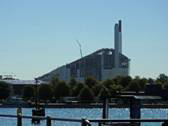 Much of our tour today was by car. An aside about cars. Copenhagen doesn't want cars in the central city. It makes it very expensive to own one. It taxes most cars at 100% and luxury cars at 200%. (Stockholm charges a special tax for cars that enter the central city.) Consequently, bicycles are king and queen and everything else. Even though this is a city of experienced bikers, it is considered dangerous to cross a bike lane when not at a light.
Much of our tour today was by car. An aside about cars. Copenhagen doesn't want cars in the central city. It makes it very expensive to own one. It taxes most cars at 100% and luxury cars at 200%. (Stockholm charges a special tax for cars that enter the central city.) Consequently, bicycles are king and queen and everything else. Even though this is a city of experienced bikers, it is considered dangerous to cross a bike lane when not at a light.
As we drove along the seashore, the guide pointed out a building that was both interesting architecturally and because of how it is used. It's the Copenhagen incinerator and it's been around for decades. The garbage that's burned provides electricity and, with the steam that would otherwise go to waste, water is heated and piped throughout the city to heat buildings. This use of hot water-heated buildings is prevalent in major Swedish cities as well (although in Helsinki coal is burned). Iceland also uses a system of piped hot water to heat buildings but gets its heated water from geothermal sources. Finally, note the slope of the roof of the building. It's actually used as a ski slope as well. Talk about multi-tasking.
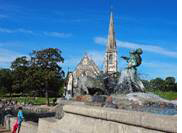
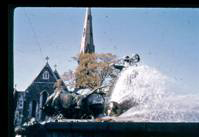 Another "must see" is the largest bronze statue in Copenhagen. It is Prometheus plowing land that is said to have become one of Denmark's islands. Again, the picture on the left was taken today and the one on the right, 50 years ago. We again met up with bus loads of Chinese tourists at this site.
Another "must see" is the largest bronze statue in Copenhagen. It is Prometheus plowing land that is said to have become one of Denmark's islands. Again, the picture on the left was taken today and the one on the right, 50 years ago. We again met up with bus loads of Chinese tourists at this site.
The Palace square is spacious, with a circle of buildings all pointing inward - to cobblestones and cobblestone mosaics. We were there for the changing of the guard.
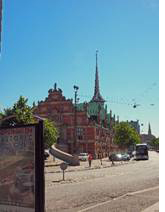 Copenhagen was once a commercial port with lots of manufacturing and warehouses in the center of town - buildings which today are repurposed into residences or offices. One of the more interesting of these is the building where merchants had small ground floor rooms where they sold and traded their goods. On the top of this building is a spire made up of four twisted dragons. The dragons were thought to protect the merchandise because they represented good luck. Today the places are offices.
Copenhagen was once a commercial port with lots of manufacturing and warehouses in the center of town - buildings which today are repurposed into residences or offices. One of the more interesting of these is the building where merchants had small ground floor rooms where they sold and traded their goods. On the top of this building is a spire made up of four twisted dragons. The dragons were thought to protect the merchandise because they represented good luck. Today the places are offices.
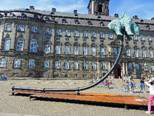 The city is full of public art. Much of it is the typical powerful king or conquering general kind of monument. One sculpture in front of City Hall is a striking statement about the city's view (and I'm sure Denmark's belief as well) on the causes and consequences of global warming. It shows a pipe representing carbon dioxide emissions. The left end of the pipe is the year 1700. It is relatively flat until 1800. After that point it shoots up rapidly particularly starting in 1900. The result is represented by the cumulative CO2 emissions ultimately skewering a polar bear. It is an extraordinarily powerful but brilliantly basic sculptural "story".
The city is full of public art. Much of it is the typical powerful king or conquering general kind of monument. One sculpture in front of City Hall is a striking statement about the city's view (and I'm sure Denmark's belief as well) on the causes and consequences of global warming. It shows a pipe representing carbon dioxide emissions. The left end of the pipe is the year 1700. It is relatively flat until 1800. After that point it shoots up rapidly particularly starting in 1900. The result is represented by the cumulative CO2 emissions ultimately skewering a polar bear. It is an extraordinarily powerful but brilliantly basic sculptural "story".
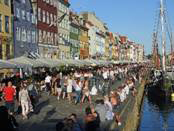 The main city canal is crowded with everything including residents, workers, builders, boats, trucks, shops and of course, since it's high summer, tourists. It is also architecturally alive, lively, and colorful with every building painted a different color.
The main city canal is crowded with everything including residents, workers, builders, boats, trucks, shops and of course, since it's high summer, tourists. It is also architecturally alive, lively, and colorful with every building painted a different color.
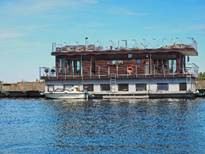 We took a boatride around the harbor, a great way to see Copenhagen. That was especially true today since it was probably around 80 F+, bright sun, and virtually no wind. It was therefore very cooling to be on the water. The boat was originally owned by the Crown Prince (in the Twenties), and the skipper said that he had recently given a tour to the grandchild of the current queen. The shoreline was full of old industrial warehouse buildings that are rapidly being changed into offices and residences. There was also an area a bit of a distance from city center where a dozen or so houseboats were moored. These residences looked quite upscale. Like in Salsalito, these berths, both along the waterfront and on the canals, are scarce and in great demand. As long as the houseboats are kept up, the government allows them to stay.
We took a boatride around the harbor, a great way to see Copenhagen. That was especially true today since it was probably around 80 F+, bright sun, and virtually no wind. It was therefore very cooling to be on the water. The boat was originally owned by the Crown Prince (in the Twenties), and the skipper said that he had recently given a tour to the grandchild of the current queen. The shoreline was full of old industrial warehouse buildings that are rapidly being changed into offices and residences. There was also an area a bit of a distance from city center where a dozen or so houseboats were moored. These residences looked quite upscale. Like in Salsalito, these berths, both along the waterfront and on the canals, are scarce and in great demand. As long as the houseboats are kept up, the government allows them to stay.
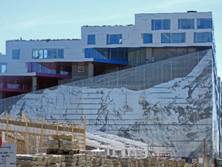 We spent some time traveling around the outskirts of Copenhagen seeing newly developed residential/office areas that probably weren't even on the drawing boards when we were here nearly two decades ago. There were lots of high rise structures, designed to not look like the high rise rectangles they are.
We spent some time traveling around the outskirts of Copenhagen seeing newly developed residential/office areas that probably weren't even on the drawing boards when we were here nearly two decades ago. There were lots of high rise structures, designed to not look like the high rise rectangles they are. 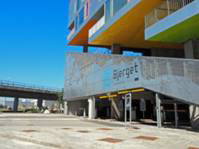 The Danes have excelled in design, not only in furniture but in architecture. One building was particularly noteworthy. It was a ten story parking structure whose interior was built on a slant. The space that would be used for parking if the structure were a regular parking-garage rectangle instead of this "triangle" shape was instead filled with spacious, dramatic apartments. The floors of the gararge rise from the main parking floor to the top with each floor parking fewer cars. To travel from the first level to the top level of the gararge (and the apartments off the gararge floor), the architect designed a finicular-like elevator. To top off this structural rethinking of space, the gararge is covered by what look like a black and white photograph - but in reality was composed of large aluminum squares punched with holes of different sizes that create the illusion of a Mont Blanc photo.
The Danes have excelled in design, not only in furniture but in architecture. One building was particularly noteworthy. It was a ten story parking structure whose interior was built on a slant. The space that would be used for parking if the structure were a regular parking-garage rectangle instead of this "triangle" shape was instead filled with spacious, dramatic apartments. The floors of the gararge rise from the main parking floor to the top with each floor parking fewer cars. To travel from the first level to the top level of the gararge (and the apartments off the gararge floor), the architect designed a finicular-like elevator. To top off this structural rethinking of space, the gararge is covered by what look like a black and white photograph - but in reality was composed of large aluminum squares punched with holes of different sizes that create the illusion of a Mont Blanc photo.
This is just an amazing city, with a book's worth (as opposed to blog's worth) of sights. But it made a great end to our Scandanavian adventure by road. Having done this current trip from Helsinki to Copenhagen rather than from Copenhagen to Helsinki as I did 50 years ago, I can see why Helsinki seemed to be so blah back then when compared to the more cosmopolitan cities of Stockholm and Copenhagen. But they all were fun - interesting - and worth seeing (even again).
Tomorrow we board the Seabourn Quest and begin our Norwegian fjords cruise.
